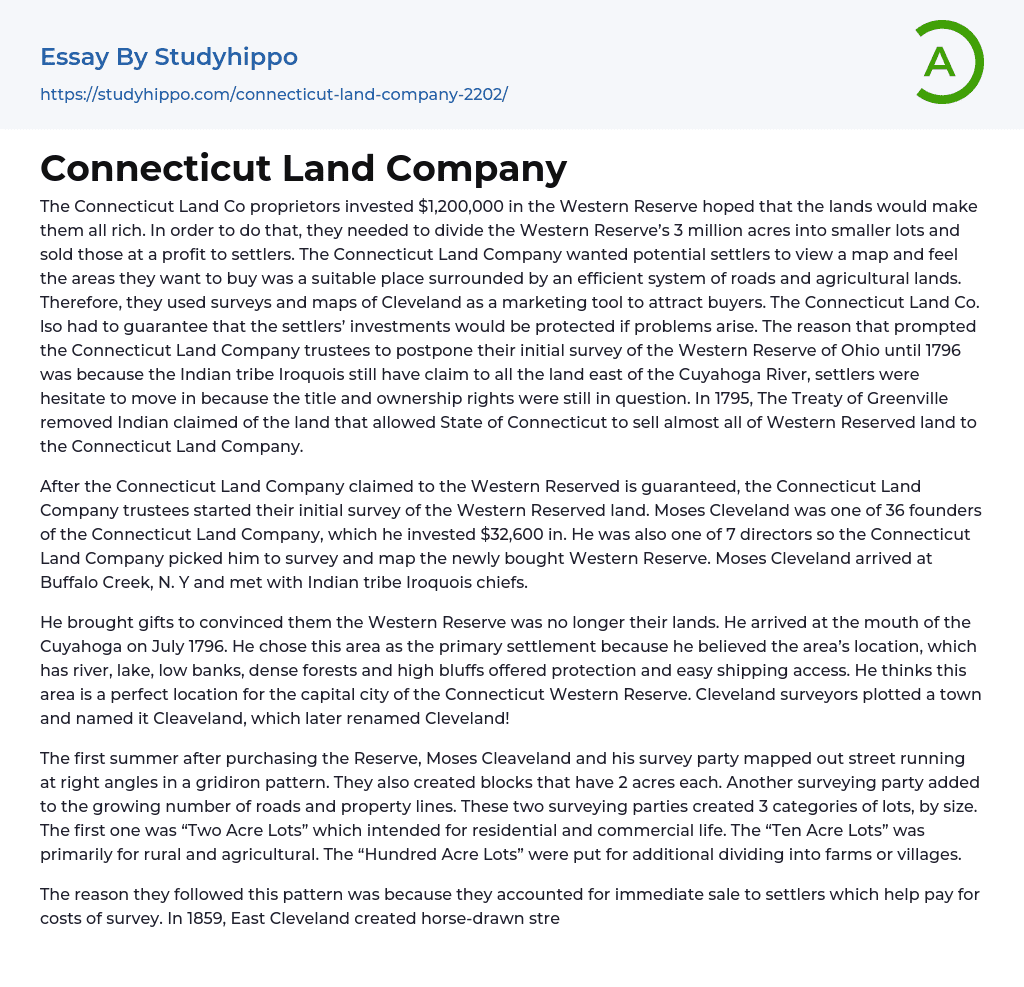The Connecticut Land Co proprietors invested $1,200,000 in the Western Reserve hoped that the lands would make them all rich. In order to do that, they needed to divide the Western Reserve’s 3 million acres into smaller lots and sold those at a profit to settlers. The Connecticut Land Company wanted potential settlers to view a map and feel the areas they want to buy was a suitable place surrounded by an efficient system of roads and agricultural lands. Therefore, they used surveys and maps of Cleveland as a marketing tool to attract buyers. The Connecticut Land Co. lso had to guarantee that the settlers’ investments would be protected if problems arise. The reason that prompted the Connecticut Land Company trustees to postpone their initial survey of the Western Reserve of Ohio until 1796 was because the Indian t
...ribe Iroquois still have claim to all the land east of the Cuyahoga River, settlers were hesitate to move in because the title and ownership rights were still in question. In 1795, The Treaty of Greenville removed Indian claimed of the land that allowed State of Connecticut to sell almost all of Western Reserved land to the Connecticut Land Company.
After the Connecticut Land Company claimed to the Western Reserved is guaranteed, the Connecticut Land Company trustees started their initial survey of the Western Reserved land. Moses Cleveland was one of 36 founders of the Connecticut Land Company, which he invested $32,600 in. He was also one of 7 directors so the Connecticut Land Company picked him to survey and map the newly bought Western Reserve. Moses Cleveland arrived at Buffalo Creek, N. Y and met with India
tribe Iroquois chiefs.
He brought gifts to convinced them the Western Reserve was no longer their lands. He arrived at the mouth of the Cuyahoga on July 1796. He chose this area as the primary settlement because he believed the area’s location, which has river, lake, low banks, dense forests and high bluffs offered protection and easy shipping access. He thinks this area is a perfect location for the capital city of the Connecticut Western Reserve. Cleveland surveyors plotted a town and named it Cleaveland, which later renamed Cleveland!
The first summer after purchasing the Reserve, Moses Cleaveland and his survey party mapped out street running at right angles in a gridiron pattern. They also created blocks that have 2 acres each. Another surveying party added to the growing number of roads and property lines. These two surveying parties created 3 categories of lots, by size. The first one was “Two Acre Lots” which intended for residential and commercial life. The “Ten Acre Lots” was primarily for rural and agricultural. The “Hundred Acre Lots” were put for additional dividing into farms or villages.
The reason they followed this pattern was because they accounted for immediate sale to settlers which help pay for costs of survey. In 1859, East Cleveland created horse-drawn streetcar line that allowed other companies to expanded outward distance areas. Other companies laid tracks that to distance areas. Nickel Plate Railroad upgraded the dummy lines to offer limited commuter service. The horse-drawn street railways allowed people to moved out to suburban area up to 3 miles away from downtown that promote suburban development.
Later improvement from horse-drawn to electrified streetcar allowed suburban development to increased from 3
miles to 10 miles from the city center. New streetcar lines allow residents to moved out from downtown area to establish villages such as East Cleveland, Lakewood and Cleveland Heights. Fast population growth helped transform those villages to city status by the end of 1903. Streetcar and rapid transit also developed a second suburban ring such as city of Bedford, Berea, Parma and many new villages.
- Bankruptcy essays
- Earnings essays
- Tata Group essays
- S corporation essays
- Secretary essays
- Premise essays
- Cars essays
- Bicycle essays
- Rms Titanic essays
- Renault essays
- Truck essays
- chrysler essays
- The city essays
- Racing essays
- Adidas essays
- Amazon essays
- Apple essays
- Bmw essays
- British Airways essays
- Burger King essays
- Coca-Cola essays
- Company essays
- Costco essays
- Dell essays
- Ebay essays
- Enron essays
- Facebook essays
- Ford Motor Company essays
- Gap essays
- General Motors essays
- Google essays
- Honda essays
- Ibm essays
- Ikea essays
- Intel essays
- Iphone essays
- Johnson and Johnson essays
- Kellogg essays
- Key essays
- Kfc essays
- Mcdonald's essays
- Microsoft essays
- Myspace essays
- Nestle essays
- Netflix essays
- Nike essays
- Nokia essays
- Pepsi essays
- Pepsico essays
- Red Bull essays




